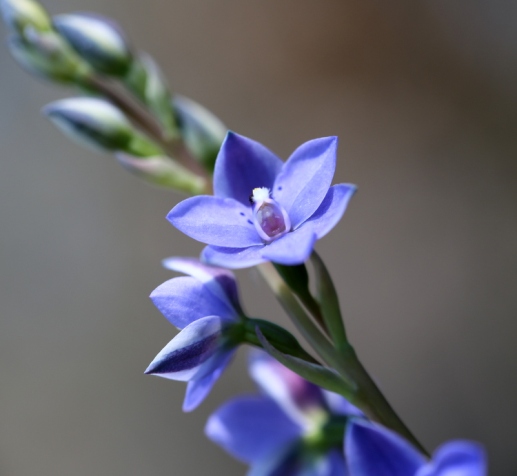Sun orchids
These native orchids have been in flower, now, since the beginning of October. They’ve opened in the sunny, humid days particularly on the eastern side of the Reserve. There are others currently in bud on the western side. Sun orchid species recorded in the Reserve in the past have included Thelymitra ixioides, T. rubra, T. carnea, T. media and T. flexuosa.
Sun orchids are different from other orchids as their petals are the same shape as their sepals and labellum. This means they look like a regular flower. It is their column – the central structure – that attracts pollinators and which distinguishes different species. They are pollinated by native bees and hover flies or through self-pollination and seed dispersal takes eight to 12 weeks afterwards. They are strongly responsive to bushfire, with increased flowering the following year. Jeanes and Backhouse (2006) also point out that sun orchids species have a tendency to hybridise which can make precise identification a challenge.
Here are some of the pinks, mauves and blues flowering more recently.
T. ixiodes or Spotted sun orchid
‘Ixia’ like, this sun orchid is also spotted. This is a common orchid in Victoria, flowering from September to January, in general (although, it is a shorter season than this in the Reserve.) The flower stays open for around a week with pollination by native bee. It is described as a more robust orchid, with flowers that open freely and a stem up to 65cm. After pollination during spring, it dies back to its underground tuber.
T. juncifolia or Rush-leaf sun orchid
This sun orchid is also blue, spotted and has a similar appearance to the Spotted one. It is, however, described as more slender, to 45cm tall and is self-pollinating. Its flowers are also described as being open less often, opening between September to November.
The differences between ixioides and juncifolia lie in the appearance of the column – it appears to be around the density of the finger-like glands around the mid-lobes and accessory lobes, as well as the sparcity of the hair tufts on the column arms. It seems that both varieties can be seen around the Reserve.
T. rubra or Salmon sun orchid
These sun orchids are salmon pink. The stems are reddish and the orchid flowers September to November, growing to 50cm tall. The column has a reddish collar and yellow apex, and lateral lobes are short and fringed, without hair tufts. The surrounding petals are pointy – ‘apiculate’.
T. pauciflora or Slender sun orchid
This is widespread in Victoria, growing up to 40 or 50cm tall, with pale blue, pink or white flowers. The column is hooded and notched – although can be smooth – with a yellow apex and brownish shading post-anther. There are white tufted column arms. Flowering September to November, this is a self-pollinating orchid described as opening reluctantly on warm days.
Sources and further resources
Australian Native Plants Society (2007) Thelymitra Ixioides. http://anpsa.org.au/t-ixi.html
Bishop, T. (2000) Field guide to the orchids of New South Wales and Victoria. UNSW Press: Sydney
Duncan, M. – DSE (2012) Response of orchids to bushfire. Black Saturday Victoria 2009 – Natural values fire recovery program. http://www.dse.vic.gov.au/__data/assets/pdf_file/0011/137828/VBRRA-P27-web-rev.pdf
Jeanes, J. & Backhouse, G. (2006) Wild orchids of Victoria Australia. Aquatic Photographics: Seaford.
Mayfield, E. (2010) Flora of the Otway Plain and Ranges 1. CSIRO Publishing; Collingwood.
There are some great sites and blogs on orchids. For a couple of good ones for great images and information about orchids:
Retired Aussies.com – http://www.retiredaussies.com/ – select ‘Victoria’
Anglesea orchids – http://www.angleseaorchids.com/

When i finish working on the car, i hope to be able to visit the reserve when there is another one of those native working bees :-)… and take some more pics. The ones you show have inspired me to do the same. Breathtakingly interesting information.
RE: The “hover flies” that were mentioned.
It is good to see a big increase of these beings lately in the backyard, and in general. They especially have been attracted to a variety of bullrushes that seem to be capable of growing to over three meters in height. After a few years of seeding them into other parts of the garden, they have become prolific. Now there are an abundance of these almost prehistoric size bullrushes, and with them seemingly, an increase in the native hover fly population like clouds around the bullrushes that i have noticed this year.
Unfortunaetly, there has also been an increase in European wasp, and these seem to be quite capable of catching a hoverfly in mid flight. I have a fairly good quality short video of this taking place in front of the camera whilst i was filming a hover fly. The European wasp literally ‘stole the show’ and landed its prey hanging on with one leg to the plant using its other five to adjust the payload (Hover fly) before making off. Gladly, i see vastly more hoverflies than European wasps.
Strewth, looks like no spotted sun orchid is the same or ever has been.
Hi Mike 🙂 When you’re able to visit the Reserve, there are some sun orchids in bud in the southern section between Toyes Track and Borrmans Street…ready to be seen when the sun’s back out.
Thanks 🙂 …. looking forward to the next weed blitz
What a Beautiful Sanctuary- Comforting to see you keeping it “Sacred”
Remember,
‘WE’ have just so many Heart Beats, Use them Wisely…. my Fellow Travelers….
an observer from Maine-USA